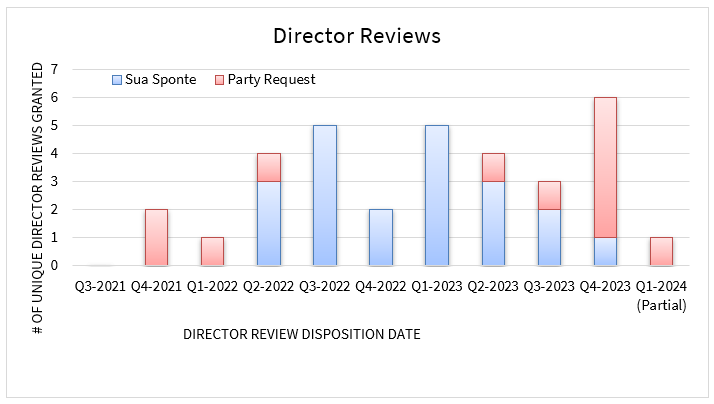Update on Director Review Grants of PTAB Decisions 2.5 Years After Arthrex
Client Alert | 15 min read | 02.26.24
Starting in June 2021, the U.S. Patent and Trademark Office (USPTO) instituted a policy to allow for the Director of the USPTO to review certain decisions by the Patent Trial and Appeal Board (PTAB) issued in inter partes reviews (IPRs) and post grant reviews (PGRs). That process, known as Director Review, was created in response to the decision in United States v. Arthrex, Inc., whereby the Supreme Court held that final written decisions of administrative patent judges in IPR proceedings must be subject to the review of the Director of the USPTO before they become the decisions of the agency. 141 S. Ct. 1970 (2021).
The USPTO has not yet formalized its process for Director Review, but has issued a series of evolving interim guidelines for governing how and when the Director will review PTAB decisions, with the most recent update occurring on January 19, 2024.[1] Director Review is available for: (1) institution decisions (as of July 2023), (2) final written decisions, and (3) decisions granting a request for rehearing of either of those decisions.
A party to a proceeding may request Director Review of an institution decision (or decision requesting rehearing of such decision) in view of an (a) abuse of discretion or (b) important issues of law or policy. A party may request a Director Review of a final written decision (or decision requesting rehearing of such decision) in view of an (a) abuse of discretion, (b) important issues of law or policy, (c) erroneous findings of material facts, or (d) erroneous conclusions of law.
The Director also has unilateral discretion to grant review of PTAB decisions sua sponte. The USPTO guidance states that sua sponte Director Review is typically reserved for issues of “exceptional importance.”
The Director Review process has been available for over 2.5 years, and the Director has stepped in to review numerous PTAB decisions. The chart below shows the number of unique[2] Director Reviews granted by quarter – in response to a party request or sua sponte by the Director – since the process has been available.[3]

Interestingly, there have been 12 unique Director Reviews granted in response to party requests, and 21 unique Director Reviews granted sua sponte. Thus, a high percentage of the reviews have been granted sua sponte – which is supposed to be reserved for issues of exceptional importance – rather than in response to a request by one of the parties. The lack of Director Reviews granted in response to a party request, however, has not been from a failure by parties to request reviews, as the data shows that the USPTO has only granted Director Review on 5.3% of the decisions when a review has been requested by a party. With that said, as shown in the chart above, the proportion of requests granted based on a party request, instead of sua sponte, has increased recently.
Throughout this Director Review process, the Director has issued numerous notable decisions intended to shape the PTAB practice and the USPTO’s policy. For example, the following Director Review decisions have been deemed precedential:[4]
- In CommScope Techs. LLC v. Dali Wireless, Inc., the Director instructed the PTAB to reach the “compelling merits” Fintiv factor only if the first through fifth Fintiv factors favor discretionary denial. IPR2022-01242, Paper 23 (Feb. 27, 2023).
- In Nested Bean, Inc. v. Big Beings Pty Ltd., the Director clarified that the PTAB is required to consider the patentability of alternative dependencies of a multiple dependent claim. IPR2020-01234, Paper 42 (Feb. 24, 2023).
- In the OpenSky and Patent Quality Assurance decisions, the Director identified sanctionable conduct that was determined to be abusive to the IPR proceeding. OpenSky Industries, LLC v. VLSI Technology LLC, IPR2021-01064, Paper 102 (October 4, 2022); Patent Quality Assurance, LLC v. VLSI Technology LLC, IPR2021-01229, Paper 102 (Dec. 22, 2022).
- In NXP USA, Inc. v. Impinj, Inc., the Director specified that the only appropriate time for a petitioner to offer a stipulation related to Fintiv factor 4 is prior to the PTAB’s decision on institution. IPR2021-01556, Paper 13 (Sept. 7, 2022).
- In Code200, UAB v. Bright Data, Ltd., the Director provided guidance for how the PTAB should evaluate serial petitions, explaining that when the first-filed petition was not evaluated on its merits, General Plastics factors 1-3 only weigh in favor of discretionary denial when there are “road-mapping” concerns under factor 3 or other concerns of fairness related to factor 2. IPR2022-00861 & IPR2022-00862, Paper 18 (Aug. 23, 2022).
Notably, each of these precedential decisions was issued in cases where the Director granted review sua sponte.
In view of evolving guidance for the Director Review process, including types of decisions that are eligible for review and internal PTAB processes for determining which decisions to review, it will be interesting to see how active the Director continues to be in reviewing PTAB decisions in 2024 and beyond.
[1] The current Director Review guidance setting forth these standards can be found at the following link: Revised Interim Director Review Process, https://www.uspto.gov/patents/ptab/decisions/revised-interim-director-review-process (last visited Feb. 26, 2024).
[2] On occasion, the Director will grant review on the same day for multiple decisions involving proceedings between the same parties. Typically, that will involve situations where the parties are engaged in multiple proceedings concerning the same or related patents, and the Director Review will primarily focus on a single or related issue across all such proceedings. For purposes of this analysis, each “set” of such proceedings is being counted as a single, unique Director Review.
[3] The source of this data is the USPTO’s website, which provides information on the status of Director Review requests up until February 15, 2024. See https://www.uspto.gov/patents/patent-trial-and-appeal-board/status-director-review-requests (last visited Feb. 26, 2024).
[4] A precedential decision establishes binding authority concerning major policy or procedural issues, or other issues of exceptional importance, including constitutional questions, and important issues regarding statutes, rules, and regulations. See https://www.uspto.gov/patents/ptab/precedential-informative-decisions (last visited Feb. 26, 2024).
Contacts
Insights
Client Alert | 3 min read | 04.01.25
D.C. Circuit Rejects Copyrightability of Artwork Created Autonomously by AI
In a unanimous opinion issued by the D.C. Circuit on March 18, 2025, the Court of Appeals affirmed denial of Dr. Stephen Thaler’s application to register a copyright protection for a work created by his generative artificial intelligence system, holding that the Copyright Act requires human authorship.
Client Alert | 2 min read | 04.01.25
Client Alert | 4 min read | 04.01.25
For Better or MORSE: Another Settlement Under DOJ’s Civil Cyber-Fraud Initiative
Client Alert | 4 min read | 04.01.25
Hatch-Waxman PTE for Reissue Patents Should Be Calculated From the Original Patent’s Issue Date



